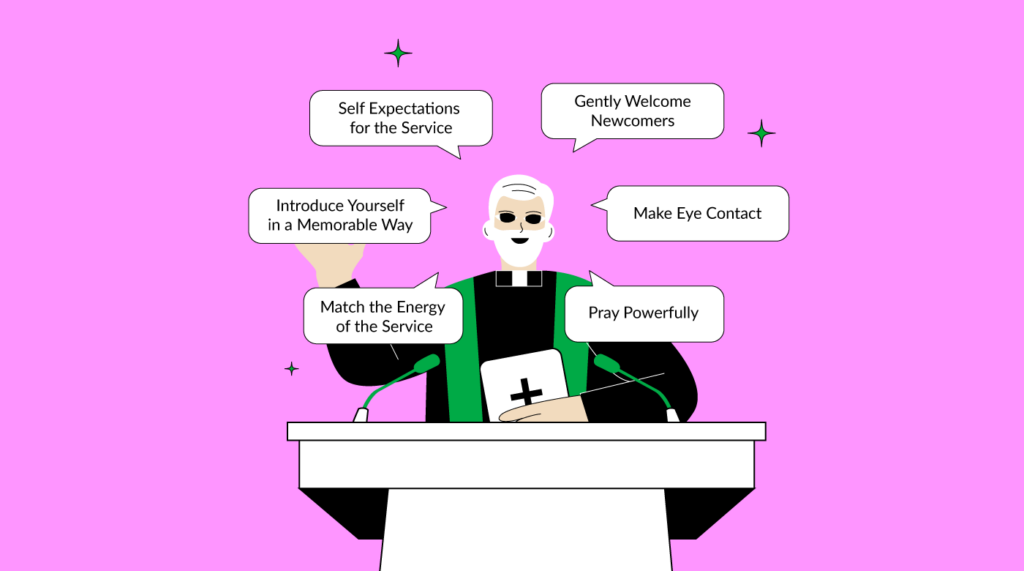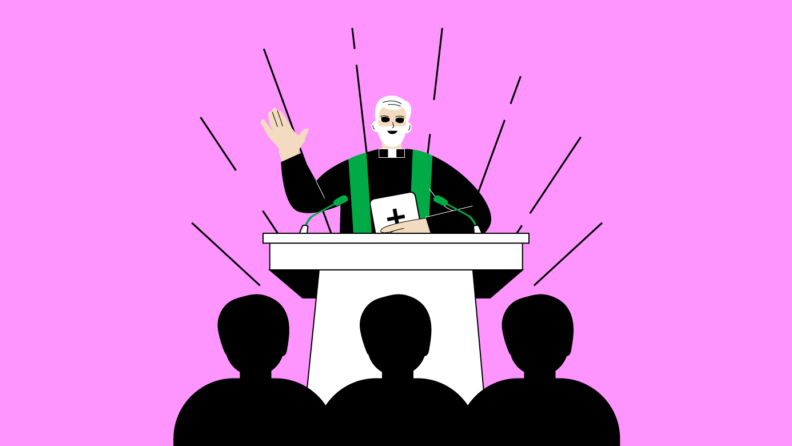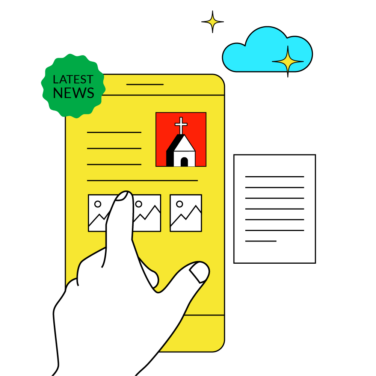Every church has a liturgy, a process, and an order of worship, but not all services include the church welcome as an intentional and important part of the worship service. Taking the time to create and engage in a church welcome speech, ceremony, or ritual is important in order to invite God’s people into fulfilling worship.
Especially for first-time guests, the church welcome speech can be an integral part of their assessment of the church. With that in mind, let’s dive into the what, why, and how of the welcome portion of our church services and liturgy.
What Is A Church Welcome?
The church welcome, whether you call it the meet-and-greet or “turn to your neighbor,” or it is a simple welcome speech, is a regular part of most contemporary churches. However, as I pointed out earlier, just because it is part of the church service doesn’t mean that anyone, either church leaders or church members, has given it much thought.
A church welcome speech might include practical information such as generally welcoming people, welcoming visitors, or even communicating upcoming events. These welcome messages might also set expectations for the service or specifically invite first-time visitors.
A typical Sunday service might also include a moment for the church community to welcome and greet church visitors, too.
No matter how your church practices the church welcome portion of your worship service, if you want to be a welcoming church, then you are going to have to put some extra time, energy, and effort into the church welcome being a special part of the service.
What is a Church Welcome Speech?
To put it simply, a church welcome speech is the onstage greeting you give for every church service.
In fact, the consistency of the church welcome speech can go a long way to connecting with the church’s mission. This is why it is so important to plan and rehearse this overly simple step of the liturgy, the worship, just like you would any other song or ritual.
While you could just say, “Good morning!” and call it a day, if you want to encourage new members and new visitors to keep coming back, then they need to know that you are making the entire Sunday service experience intentional, powerful, and missional.
People want to have a warm welcome, of course, but they also want to know that they belong to a greater mission and vision. This goes beyond a bumper sticker with your church name and logo or even inviting friends to a church program or church event. They want to know they are a part of something grander than sitting in a chair or pew for an hour a week.
The church welcome speech, as small as it is, has the potential to communicate the church’s mission clearly, consistently, and often so that church members who have been around for decades and visitors coming in on Christmas or Easter know why your church exists.
Why Is A Church Welcome Important?
Aside from the church welcome speech, why is the rest of the church welcome portion of the service so important? Isn’t it just saying a quick greeting, going over the morning announcements, and moving on to the next song?
I am a Christian who has been to multiple churches, worked on staff at a few different churches, and I’ve attended churches from all kinds of denominations from Baptists to Nondenominationals to Pentecostals to Nazarenes. And I can tell you the church welcome is one of the first opportunities for a visitor to start tuning out or start thinking about calling a church “home.”
I’ve seen churches who have done the church welcome well and those who you can tell never put more than a handful of minutes of thought into the church welcome. On a Sunday morning, the welcoming church, the church people want to be a part of, the church people feel they belong to, is the one who has their church welcome down to a science.
The church welcome communicates the church’s mission, but also the mission of Jesus Christ and the power of the Holy Spirit. When done correctly, a 1-2 minute church welcome portion of worship can bring everything the Church is about together in one smooth transition.
How To Give A Church Welcome

Knowing what you need to pack into the church welcome is one thing, putting it into practice is another. Trying to squeeze too much in by taking the time to read from the Bible, mention your connect cards, invite those who are new church attendees, as well as offer up a time of prayer before launching the rest of the service can overwhelm rather than invite others into the service.
Coming up with church welcome ideas isn’t a difficult task. Understanding how to incorporate everything into an integral part of the liturgy is the tricky part, though. Here are some tips to make the church welcome helpful, informative, and transformative for members and guests of your church.
1. Match the Energy of the Service
If you are intentionally creating your church welcome as part of your liturgy, then every single one will be slightly different and will match the overall energy of the rest of the service.
Think of it this way, if the church welcome speech is short, sweet, and a bit somber but the worship music is upbeat, fast-paced, and loud, then it feels disjointed. Likewise, if the church welcome is peppy and then the rest of the service is serious, then it feels like you haven’t been prepared for the rest of the service.
2. Introduce Yourself In a Memorable Way
It seems simple, but people tend to forget to introduce themselves during the welcome speech. More importantly, introduce yourself in a way that allows people to connect with you.
For example, rather than say, “I’m Dylan, the Lead Pastor,” you could say, “My name’s Dylan, and my daughters were the ones running with fistfuls of donuts through the lobby.” This allows people to connect with you as a person, not you as a role.
3. Set Expectations For the Service
First-time guests likely won’t know what to expect, and regular attendees won’t mind being reminded. Setting expectations for how the service will flow, how you want people to interact throughout the service, etc. are great ways to help them feel invited into the worship not simply thrust into it.
A simple way to practice this is simply saying, “Once I’m done here, we are going to enter a time of worship through music. We invite you to sit, stand, whatever you feel most comfortable doing. Afterward, we will engage with the word of God through a sermon and a time of reflection.”
It doesn’t take much time but has an opportunity to connect to a lot of your church mission and vision as well as making people feel far more comfortable.
4. Gently Welcome Newcomers
The biggest part of the church's welcome is to invite new guests. Make sure not to call any guests out in particular and to make it as simple as possible. Don’t overwhelm first-time guests by making them stand, shake hands, or fill out a connect card on the spot.
As an example, “To all of our first-timers, thanks for coming. During or after the service, we’d love for you to fill out a connect card or chat with any member of our welcome team. We promise not to bombard you unless you want us to.”
5. Make Eye Contact
Even if your stage lights are bright, try to find at least one person to make eye contact with during your church welcome speech. Finding as many people as possible and making eye contact can make all the difference to whether or not someone is listening in and, more importantly, feeling included in the warm welcome.
6. Pray Powerfully
It’s common practice to close out the church welcome with prayer as you transition to the next stage of the liturgy, but don’t let these moments slip away. These are an opportunity to share with guests and regular attendees what it means to pray, how your specific church engages with the Holy Spirit, and how you are living out the teachings of Jesus Christ.
Short is great, but meaningful, intentional, and powerful prayer is more important than keeping the church welcome speech down to a brisk three minutes.
What To Include In A Church Welcome
Like we have covered already, at its core, a church welcome is about giving a warm, inviting greeting to members and guests alike, sharing practical information about setting expectations for the service, and encouraging some kind of follow-up or follow-through for first-time guests. However, making sure your church welcome is in alignment with your church mission is vital.
If you have a church mission or vision statement, make sure to share it. If there are upcoming events, make sure it is in your church welcome speech. Making the church welcome a part of the worship and liturgy of your service will go a long way to communicating your church’s values and making others, including first-time guests, feel included.
5 Examples Of Church Welcomes
While you want your church welcome time to be similar for every service, having templates handy for different events that add to the overall church welcome speech is important to make every special occasion feel unique. With that in mind, here are 5 examples of church welcomes you could use for specific situations.
Easter Sunday
“Good morning! He is risen! My name is [Name] and I have been celebrating Easter with [family member names] for [Number of Years]! Welcome to [Church Name], we are so glad to celebrate this holiest of days with you!
We are going to be continuing our Easter service today with [Elements of the Service]. At [Church Name] we completely understand you may or may not be celebrating with us today, and that’s okay. We encourage you to participate or not any way you like.
If this is your first time celebrating Easter with us, then we would love for you to either fill out a connect card during or after the service. If you’d rather make a personal connection directly, one of our members has volunteered to give you a warm welcome and help answer any questions for you before, during, and after our service today!
Now, let’s continue celebrating the resurrection of Jesus Christ in prayer.”
Baptism
“Good morning and welcome to [Church Name]! My name is [Name] and I have had the pleasure of being baptized for [Number of Years], which is why I am so excited to celebrate these baptisms going on today!
For context for first-time guests with us today, baptism is [explanation of your church’s stance and process of baptism]. This is a time to celebrate, encourage, and participate in the life of those who call themselves a part of our community. If you don’t yet consider yourself to be part of this community, we invite you to celebrate as much as you can along with us.
We are going to keep worshiping through music, the word of God, a message, and the practice of baptism. If you are visiting with us today, we’d encourage you to check out our connect cards or visit one of our welcome committee volunteers in the lobby during or after the service.
Let’s pray and invite the Spirit to be intimately participating with us throughout this baptism service!”
Mother’s Day/Father’s Day
“Happy [Mother’s/Father’s] Day! Welcome to [Church Name], I am so glad you have chosen today of all days to worship with us! I’ve been [a mother/a father/a child] for [Number of Years] and there is no better way to start celebrating [Mother’s/Father’s] Day than being in community with other faithful followers of Jesus Christ.
Our service today will run like normal with [Order of Service], but we are going to celebrate the [moms/dads] in a special way [explanation of special orders of the service].
Let’s continue in our worship by going before God in prayer.”
Baby Dedication
“Good morning! I am [Name] and I have been blessed to be a [Mom/Dad/Uncle/Aunt/Child] and, therefore, consider events like baby dedications to be some of the most sacred and celebratory days on our calendar.
If you haven’t visited with us before, then I am personally blessed by your decision to visit today. I’d encourage you to either check out a connect card or talk directly with one of our guest service volunteers during or after the service today.
You can expect our worship service today to look like [Order of Service]. Here at [Church Name], this is one of our favorite services, so let’s continue in celebration by spending some time in prayer.”
Christmas
“Merry Christmas from [Church Name]! I’m [Name], one of the [Role] here and it is my pleasure and responsibility to say: Welcome!
If you are a first-time guest with us this morning, please make your way over to connection team members today who would love to offer you a warm welcome, answer any questions you might have, and exchange information with you so you have a point of contact here at [Church Name].
This service is a special one, but we recognize not everyone who attends a Christmas service worships the same way we do. Feel free to participate however you feel comfortable as we [Order of Service].
Pray with me as we continue our Christmas worship.”
Continue Learning About The Power Of The Church Welcome
The church welcome time of your service may seem small and insignificant, but it acts as the introductory handshake to first-time guests.
This is one of the first moments where they will be getting to see someone on stage make an announcement on behalf of the church as a whole. Making it impactful is critical to encourage visitors to come back again.
If you want to keep learning about and growing your church welcome speech, as well as other parts of organizing and managing a church, can be improved at your local church, then make sure to subscribe to The Lead Pastor newsletter and browse articles for every topic you could think of on how to better lead your church and community into the ways of Jesus Christ!



